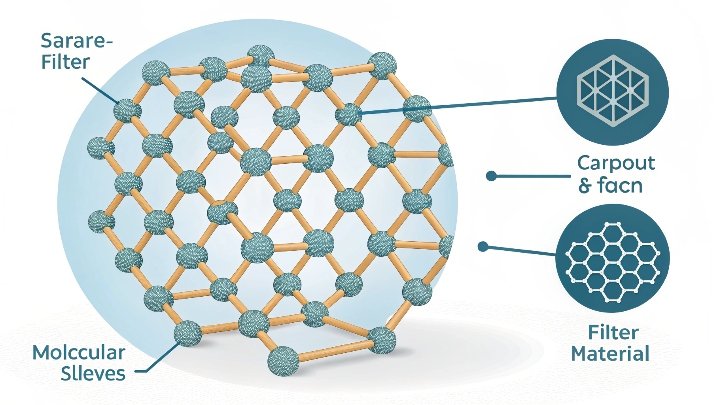I used to doubt if zeolite 13X could truly separate nitrogen from oxygen. My curiosity drove me to explore its powerful adsorption properties. I was determined to learn more.
Zeolite 13X selectively traps nitrogen molecules. Its pore openings fit nitrogen more than oxygen. By adjusting pressure, I can make the nitrogen stick to the zeolite. This leaves oxygen in a purer form. Then, the trapped nitrogen is released. This cycling process creates high-purity oxygen for various uses.
I want to explain why this process is effective. I also want to show you how it can serve both industrial and medical needs. Please keep reading to learn more.
How does zeolite separate oxygen and nitrogen?
I once tested different adsorbents to see if they could isolate these gases. I saw zeolite’s unique pore structure and realized it had a special attraction for nitrogen.
Zeolite has internal cavities that bond more with nitrogen. Because of that, oxygen stays behind in higher concentration. This principle allows separation by pressure cycling. It is simple and effective.
I have spent time comparing standard adsorbents to see what drives selective adsorption. Zeolite stands out because of how its crystal structure interacts with different molecules. I will break down the factors into smaller parts so it is easier to understand.
The role of pore geometry
Zeolite has uniform pores. These pores are sized to favor the entry of nitrogen. Nitrogen has a slightly smaller kinetic diameter than oxygen. Because of this, nitrogen migrates into the pores more quickly. Zeolite also has a stronger electrostatic attraction to nitrogen. That is a key point. When I saw how the structure improved nitrogen capture, I realized that this was a powerful tool for separating air into distinct gases.
Surface interactions
Inside the zeolite, there are cations that promote interaction with nitrogen molecules. This is not complicated. It is simply a matter of attraction. The partial charges on nitrogen interact with these sites more than oxygen does. I tested various operating pressures and discovered that at higher pressures, nitrogen adsorption is more pronounced. This leads to an oxygen-enriched stream in the effluent. When I release the pressure, nitrogen comes off. This is called Pressure Swing Adsorption (PSA).
Pressure Swing Adsorption cycle
PSA is a repeated process. I have seen it in many industrial plants. Under high pressure, nitrogen sticks to the zeolite. Oxygen passes through. Then we drop the pressure, and the nitrogen leaves the zeolite. This cycle repeats many times. It looks simple, but it is efficient. It consumes less energy than other methods. It also delivers a purity level that meets the needs of different industries.
Below is a simple table that shows the key differences between nitrogen and oxygen in this separation process:
| Factor | Nitrogen | Oxygen |
|---|---|---|
| Kinetic Diameter | Smaller | Larger |
| Electrostatic Attraction | Stronger with Zeolite | Weaker with Zeolite |
| Adsorption Pressure | Higher Stickiness | Lower Stickiness |
| Resulting Purity | Released After Desorption | Remains in Product Stream |
This process intrigued me when I first learned it. I found that zeolite’s structure is stable and works well under repeated PSA cycles. It keeps working even when conditions change. That is why it remains a common choice. I enjoy seeing how engineers use this principle to create efficient air separation systems. I think it holds great promise for future enhancements in adsorbent technology. I hope this breakdown shows how zeolite separates oxygen and nitrogen in a straightforward way.
What is zeolite 13X used for?
I used to think zeolite was only for water softening. Then I studied its broader uses. Now I know it also helps refine chemical processes.
Zeolite 13X is often used in air separation, gas purification, and moisture removal. It has larger pores than type A zeolite. It can remove bigger impurities and selectively adsorb nitrogen.
I discovered zeolite 13X when I wanted better purity in my gas streams. I found that it tackles many challenges. Here, I will explain a few areas where zeolite 13X proves its value.
Industrial gas separation
I have seen zeolite 13X in oxygen concentrators. It is common in medical facilities. I have also seen it in nitrogen generation units for food packaging. The adsorbent selectively captures certain molecules, which helps produce a cleaner end product. This property is tied to the shape and size of its pores. The pores allow zeolite 13X to hold molecules that might slip through smaller zeolite structures. This prevents contamination or provides a high concentration of the desired gas. The same principle can be applied to other gas streams, like carbon dioxide or ammonia, though the focus is usually on nitrogen and oxygen.
Moisture removal
Zeolite 13X has a high affinity for water molecules too. This was vital for me when I needed a dry gas supply to protect sensitive equipment. When water levels are too high, processes can corrode or become unstable. Zeolite 13X can adsorb moisture while maintaining structural integrity. That ability works in many environments. In practical terms, I saw that using zeolite 13X in gas lines or storage systems cuts down on humidity, which helps protect compressors, valves, and instrumentation.
Removal of larger impurities
I found that zeolite 13X can remove unwanted compounds that are bigger than the standard type A zeolite can handle. Those bigger molecules would not fit inside smaller pores. With 13X, those larger impurities get adsorbed efficiently. That leads to a purer process fluid or air stream. I saw that especially in chemical manufacturing, where small details matter. Even tiny amounts of contamination can cause problems.
Below is a simple table showing various uses of zeolite 13X:
| Application | Purpose |
|---|---|
| Air Separation | Selectively adsorbs nitrogen for O2 purity |
| Gas Purification | Removes unwanted molecules (e.g., CO2) |
| Moisture Removal | Adsorbs water for dry gas systems |
| Industrial Processes | Purifies feedstock and protects equipment |
When I learned how versatile zeolite 13X was, I realized it was not limited to a single task. Its bigger pore structure opens doors to many possibilities. As I kept studying, I noticed that zeolite 13X remained stable even after repeated use. That reliability makes it a favorite choice among different industries. From my own projects, I have seen how it enhances efficiency and improves product quality. It is an adsorbent that meets critical needs in a simple way.
How do you separate oxygen and nitrogen?
I used to assume cryogenic distillation was the only solution. Then I discovered pressure swing adsorption with zeolite 13X. It changed my perspective.
Oxygen and nitrogen separation can use cryogenic distillation or PSA technology. With PSA, I push air through zeolite 13X under high pressure. Nitrogen adsorbs. Oxygen flows out. Then I release the nitrogen.
I remember when I tried to design a system to generate high-purity oxygen without relying on large cryogenic plants. That is when I learned about PSA. I will outline the process and compare it to other methods.
Cryogenic distillation vs. PSA
Cryogenic distillation is an older, proven technology. It involves cooling air to very low temperatures. Nitrogen and oxygen condense at different points. Then I can collect each one separately. The process delivers large volumes of pure gases. But it requires a lot of energy. The equipment is big. It is not ideal for smaller-scale applications.
Pressure Swing Adsorption (PSA) is simpler. I use an adsorbent that preferentially traps nitrogen. Zeolite 13X is a strong choice. I feed compressed air into the vessel. Under pressure, nitrogen molecules attach to the zeolite. Oxygen passes through and becomes product gas. Then I reduce the pressure. The nitrogen leaves the zeolite. I vent it or store it, depending on my goal. The cycle repeats. PSA machines are smaller. They use less energy than cryogenic systems. They are also easier to install.
Key steps in PSA
- Compression: I compress ambient air.
- Adsorption: Air flows through the zeolite bed. Nitrogen sticks to the zeolite.
- Oxygen collection: Oxygen leaves the adsorber as a high-purity stream.
- Desorption: I drop the pressure, and the nitrogen leaves the zeolite.
- Regeneration: The zeolite is ready for another cycle.
This method can achieve decent oxygen purity levels. If I need extremely high oxygen purity, I might do multiple PSA stages or add more finishing steps. But for many uses, standard PSA delivers enough purity. I have seen PSA units in hospitals, labs, and small factories. They are reliable and cost-efficient.
Below is a table summarizing two main air separation methods:
| Method | Energy Usage | Scale | Purity Potential |
|---|---|---|---|
| Cryogenic Distillation | High (due to cooling) | Large installations | Very high (99%+) |
| PSA (Zeolite 13X) | Moderate (compressed air) | Small to medium scale | High (up to around 95%) |
I learned that PSA is a flexible solution. If I need extremely high purity or large volumes, cryogenic might still be better. But for many standard applications, PSA is a simpler way. In my experience, it is easier to maintain. It is also faster to set up. I like how it scales, too. I can add more adsorber beds if demand grows. That is how I handle expansions without massive capital investment.
Conclusion
Zeolite 13X is a powerful adsorbent that helps me separate nitrogen and oxygen in a simple, effective way. It boosts purity and lowers operational costs.





